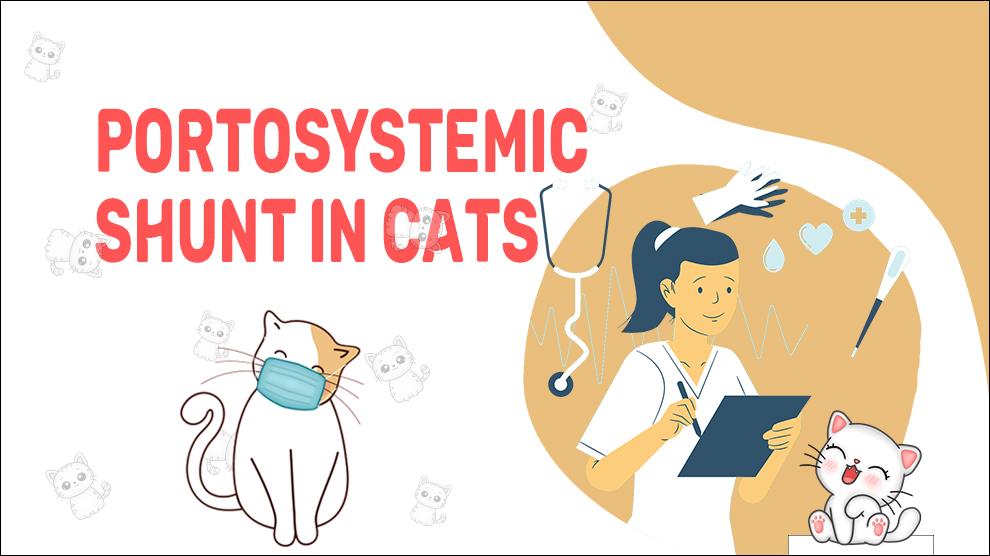What Is Portosystemic Shunt In Cats?
Portosystemic shunt (PSS) is a congenital disorder that occurs when there is an abnormal connection between the portal vein and the systemic circulation.
This abnormality causes blood to bypass the liver, which is responsible for detoxifying the blood and removing toxins from the body.
As a result, the toxins accumulate in the body and can cause severe health problems for cats.
Clinical Signs Of Portosystemic Shunt In Cats
The symptoms of PSS in cats can vary depending on the severity of the condition.
Some common signs include:
- Behavioral changes such as disorientation, confusion, and lethargy.
- Vomiting and diarrhea
- Loss of appetite
- Weight loss
- Excessive thirst and urination
- Weakness
- Seizures
- Incoordination
- Jaundice (yellowing of the skin and eyes)
- Abdominal distension
- Poor growth and development in kittens
- Unpleasant odor from the mouth due to the presence of toxic substances in the blood
- Excessive Saliva
- Loss Of Vision
- Bumping Into Things
It’s important to note that some cats with PSS may not show any clinical signs, and the condition may only be detected during routine blood work or an ultrasound exam.
Treatment Options For Portosystemic Shunt In Cats
The treatment for PSS in cats depends on the severity of the condition.
Mild cases may be managed with dietary modifications and medications, while more severe cases may require surgery.
- Dietary Modifications: A low-protein diet may be recommended to reduce the amount of toxins in the blood. Supplements such as Vitamin E and zinc may also be recommended to support liver function.
- Medications: Antibiotics may be prescribed to prevent infections, and lactulose may be prescribed to reduce the amount of ammonia in the blood.
- Surgery: In more severe cases, surgery may be necessary to correct the abnormal blood flow. This is done by creating a new blood vessel that redirects blood flow to the liver, or by closing off the abnormal vessel that’s causing the shunt.
Home Remedies For Portosystemic Shunt In Cats
While there are no home remedies for PSS in cats, there are some things you can do to support your cat’s liver function and overall health:
- Provide a balanced and nutritious diet that’s low in protein and high in antioxidants.
- Avoid giving your cat any medications or supplements without consulting your veterinarian first.
- Keep your cat’s environment clean and free of toxins.
- Provide plenty of fresh water to help flush out toxins from the body.
How To Prevent Portosystemic Shunt In Cats?
Since PSS in cats is usually congenital, there’s no way to prevent it from occurring.
However, there are some things you can do to reduce the risk of liver damage and support your cat’s overall health:
- Provide a balanced and nutritious diet that’s low in protein and high in antioxidants.
- Avoid giving your cat any medications or supplements without consulting your veterinarian first.
- Keep your cat’s environment clean and free of toxins.
- Make sure your cat receives regular veterinary check-ups to detect any potential health issues early on.
Affected Cat Breeds Of Portosystemic Shunt
Causes For Portosystemic Shunt In Cats
Causes:
In most cases, PSS in cats is congenital, which means that it’s present from birth.
It occurs when there’s an abnormal connection between the portal vein (which carries blood from the intestines to the liver) and the systemic circulation (which carries blood to the rest of the body).
As a result, the blood bypasses the liver, which is responsible for filtering out toxins, and flows directly into the systemic circulation.
This leads to a buildup of toxins in the blood, which can cause damage to various organs in the body, particularly the brain.
In rare cases, PSS can be acquired, which means that it develops later in life due to liver disease or damage.
When To See A Vet For Portosystemic Shunt In Cats?
If you suspect that your cat may have a portosystemic shunt, it is important to take them to the vet as soon as possible.
Some common signs of a portosystemic shunt in cats include stunted growth, lethargy, vomiting, diarrhea, seizures, and behavioral changes.
Early detection and treatment of portosystemic shunt can increase the chances of successful management of the condition and prevent the development of other complications such as liver failure.
It is also important to seek veterinary care immediately if your cat experiences any sudden changes in behavior or health, as this could be a sign of a medical emergency.
Food Suggestions For Portosystemic Shunt In Cats
While there are no specific dietary recommendations for cats with portosystemic shunts, it is generally recommended to feed them a high-quality, balanced diet that is low in protein.
This is because protein can increase the amount of ammonia produced in the body, which can further exacerbate the symptoms of portosystemic shunt.
Your veterinarian may also recommend specific prescription diets that are formulated to support liver function and reduce the workload on the liver.
Conclusion
Portosystemic shunt is a serious condition that requires prompt diagnosis and treatment in order to prevent long-term complications.
If you suspect that your cat may be suffering from this condition, it is important to seek veterinary care right away.
With the right treatment and management, however, many cats with portosystemic shunts are able to live happy and healthy lives.











